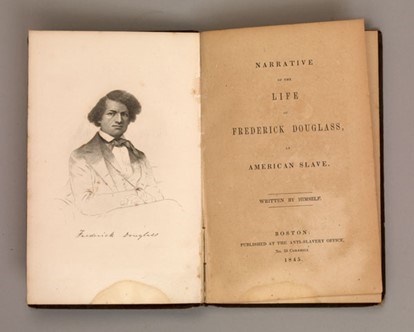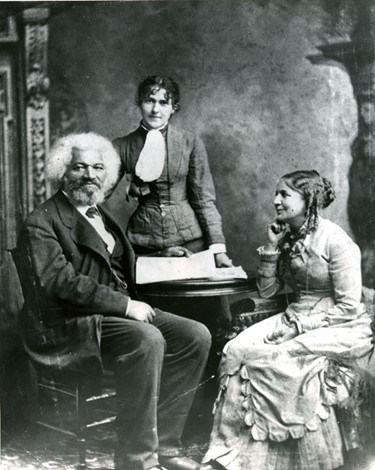Last updated: February 21, 2024
Article
Frederick Douglass and the Power of Photography

NPS Virtual Museum.
Frederick Douglass was born into slavery in 1818. He successfully sought his freedom in 1838 to the north. He lived in New York for a brief time then Bedford, Massachusetts. He maintained a home in Rochester, New York for a while before permanently moving to Washington, D.C. He poured his life into his work as an abolitionist, suffragist, public speaker, writer, government official, and civil rights activist and leader. While living at Cedar Hill during the period known as Reconstruction, Douglass continued to carry forward the struggles for racial and gender equality (LaRoche et al). For a fuller account of Black political activism after the Civil War.
From 1841 to his death in 1894, Frederick Douglass spoke, wrote and lobbied for emancipation and equality. He combined his written work with his image, as he often included his portrait with letters he sent off. Some of the portraits can be found in his Anacostia home, the historic Cedar Hill located in Washington. From 1865 to 1880, the Black population in Washington, D.C. grew over 30%, which resulted in more community-based political and economic activity. And it is from Washington, D.C. that Douglass lived a politically active life. He cultivated relationships with individuals throughout the U.S. government, including President Abraham Lincoln. Lincoln and Douglass were friends, even while criticizing each other over issues of representation and freedom. You can read more about Douglass and President Lincoln’s relationship.Frederick Douglass purchased the Cedar Hill home in 1877 in the first Washington suburb. His belief in the importance of representation is seen throughout the house in portraits, books, busts of friends in the abolitionist movement and more. In Douglass’s portraits, he is in a suit and tie, sitting with his fists clenched, and his eyes sternly focused on the camera.

National Park Service.
Photography’s Popularity
Douglass spoke on the opportunity that photographs presented to everyone. In the biography Picturing Frederick Douglass, Douglass stated that, “The humbled servant girl whose income is but a few shillings per week may now possess a more perfect likeness of herself than noble ladies and court royalty” (Stauffer et al. 2015). Commercial photography was becoming accessible and popular during his career. He saw that it could be used to communicate to a wider audience, which is exactly what Frederick Douglass did.The commercial photograph called a daguerreotype was invented in 1839 by Louis-Jacques-Mandé Daguerre. Douglass spoke highly of Daguerre as an inventor who brought forth the advancement of society through his invention. He acknowledged the growing popularity of photography and its capability to connect with its viewers. Douglass said that “Men of all conditions may see themselves as others see them” (Stauffer et al. 2015).
National Park Service
The standard for early commercial photography often called for men to sit while women and children stood. A notable photo at Cedar Hill shows Douglass, Helen Pitts and her sister Eva, posed and positioned in the same traditional 1800s style depicted for general family photos. Challenging those traditions, you see Helen is sitting and facing Douglass, his hand holding a manuscript, and Eva is standing in the background. This one picture shows support among Black and White, man and woman, and communicates both are capable and intelligent.
Through self-representation, Frederick Douglass took control of his own narrative. He powerfully conveyed the qualities and attributes that enslaved Blacks were denied since their arrival in America. Considering the American social landscape in the 1800s, the confidence he showed in early photographs helped build such a strong reputation that some people questioned if he was ever a fugitive slave (Picturing Frederick Douglass with John Stauffer 2017).
Ultimately, Frederick Douglass’ legacy shows hope for the future with technology as an aid to freedom and true equality in America. He said, “It is evident that the great cheapness and universality of pictures must exert a powerful, though silent, influence upon the ideas and sentiment of present and future generations” (Stauffer et al. 2015).
Ultimately, Frederick Douglass’ legacy shows hope for the future with technology as an aid to freedom and true equality in America. He said, “It is evident that the great cheapness and universality of pictures must exert a powerful, though silent, influence upon the ideas and sentiment of present and future generations” (Stauffer et al. 2015).
Resources Used:
Cedar Hill National Historic Sitehttps://www.nps.gov/frdo/learn/historyculture/places.htm
Frederick Douglass National Historic Site, Virtual Exhibit
https://www.nps.gov/museum/exhibits/frdo/index.html
LaRoche CJ, Fletcher P, Spencer C, Hughes L. 2021. Historic Resource Study: Reconstruction and the Early Civil Rights Movement in the National Capital Area. Historic Resource Study. National Park Service. Washington, DC https://irma.nps.gov/DataStore/Reference/Profile/2287623
Picturing Frederick Douglass with John Stauffer. Media Factory, 2017. https://www.youtube.com/watch?v=Lj0XY6NjXn4&t=1275s.
Stauffer, John, Zoe Trodd, Celeste-Marie Bernier, Henry Louis Gates, and Kenneth B. Morris. 2015. Picturing Frederick Douglass: an illustrated biography of the nineteenth century's most photographed American. Liveright. New York.
Timelines for Inventions
https://www.nps.gov/alpo/learn/historyculture/inventions.htm
African American History
-
 (H)our History: Frederick Douglass
(H)our History: Frederick DouglassThis one hour lesson provides insight into Douglass' later life when he lived in Washington, DC.
-
 The Homes of Frederick Douglass
The Homes of Frederick DouglassLearn about the life of Frederick Douglass and his role advising Abraham Lincoln.
-
 Harriet Tubman at 200Re-Imagining Harriet Tubman
Harriet Tubman at 200Re-Imagining Harriet TubmanHarriet Tubman's example as a champion of freedom and equality continues to inspire people around the world today.
Tags
- frederick douglass national historic site
- frederick douglass
- african american
- african american history
- civil rights
- frederick douglass
- washington dc
- abolition
- abolitionism
- photography
- civil war
- reconstruction
- history
- ncro
- national capital area
- national capital area national history
- equal rights
- civil rights history
- cedar hill
- ncr
